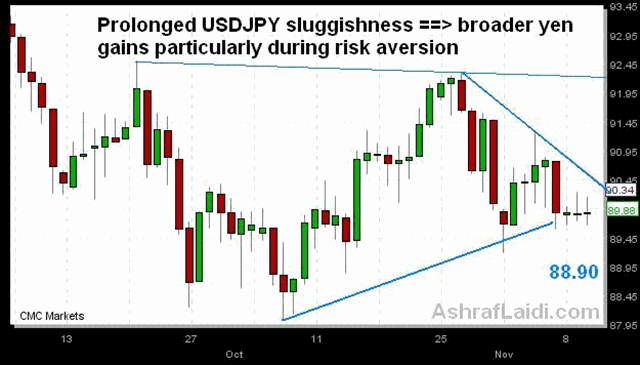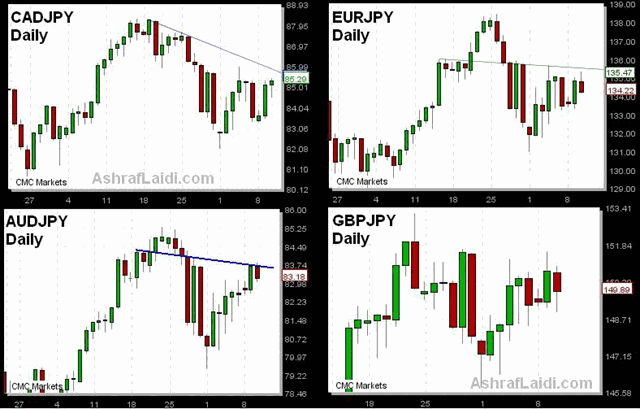Don't Forget the Yen, Especially During Risk Aversion
Currencies / Japanese Yen Nov 10, 2009 - 03:02 PM GMTBy: Ashraf_Laidi
 Much has been said about the US dollar's role as a funding currency for carry trades and its well publicized rebound during the most recent episode of risk aversion (Oct 21-Nov 2). But once again, it was the Japanese yen that outperformed the US dollar as well as all major currencies. This helps explains why the emerging gains in non-USD currencies (EUR, GBP, AUD, CAD etc) remain limited against the JPY when equity markets are on the rise and are quick to lose ground vs. JPY than against USD. Both USD and JPY pay ultra low interest rates, with 3-month LIBOR at 0.27% and 0.32% respectively. But the medium term future prospects remain brighter for JPY relative to USD.
Much has been said about the US dollar's role as a funding currency for carry trades and its well publicized rebound during the most recent episode of risk aversion (Oct 21-Nov 2). But once again, it was the Japanese yen that outperformed the US dollar as well as all major currencies. This helps explains why the emerging gains in non-USD currencies (EUR, GBP, AUD, CAD etc) remain limited against the JPY when equity markets are on the rise and are quick to lose ground vs. JPY than against USD. Both USD and JPY pay ultra low interest rates, with 3-month LIBOR at 0.27% and 0.32% respectively. But the medium term future prospects remain brighter for JPY relative to USD.
While the Federal Reserve is seen injecting emergency liquidity well into Q1, the Bank of Japan will conclude its program of purchasing of corporate debt by year-end. And with continued record bond issuance from the US treasury seen further lifting the US financial deficit to above 11% of GDP (vs. 8% for Japan), the secular case against USD shows no signs of abating. Meanwhile, as commodities respond positively to favourable dynamics for the global economy, the US dollar should once again underperform the yen.
Especially During Risk Aversion
While both USD and JPY expected to outperform other currencies during risk aversion, JPY could outshine USD during the next episode falling appetite as markets exploit it as an opportunity to sell the greenback. During the most recent period or risk aversion (Oct 21-Nov 2), the USD rebound was well publicized as the currency gained 2.6%, 3.4% and 3.8% against GBP, EUR and AUD respectively. But USD lost 2.7% against JPY, thereby, leading JPY to post greater advances versus those currencies than USD. With each and every rebound in the US dollar being strictly limited to pullbacks in global equities (G5 and EM), the emergence of such episodes does not augur well for the prospects of any looming exit strategy by the Fed.
Last weeks policy decision from the Fed and BoE confirmed that neither central bank plans to reduce liquidity before end of Q1, while the ECB maybe expected to do away with its 1-year tenders operations after its year-end review. A continuation of these policies means broader downside for the US dollar, but not necessarily so for the other funding currency the Japanese yen.
As USDJPY remains capped at 91.50, EURJPY, CADJPY and GBPJPY will likely face considerable pressure at 135.50, 85.50 and 151.50, for interim targets at 132.70, 83.80 and 148.40 respectively Selling yen crosses (buying yen) at the next wave of risk aversion should be considered--even if the media dominates the headlines with the a USD rebound. We continue to watch the 100-week MA in S&P500 (1090), 50% retracement of the decline from the 2007 high to the 2009 low (1120) and the 100-week MA in oil (81.90) as indicated in our prior piece.


By Ashraf Laidi
AshrafLaidi.com
Ashraf Laidi is the Chief FX Analyst at CMC Markets NA. This publication is intended to be used for information purposes only and does not constitute investment advice. CMC Markets (US) LLC is registered as a Futures Commission Merchant with the Commodity Futures Trading Commission and is a member of the National Futures Association.
Ashraf Laidi Archive |
© 2005-2022 http://www.MarketOracle.co.uk - The Market Oracle is a FREE Daily Financial Markets Analysis & Forecasting online publication.



